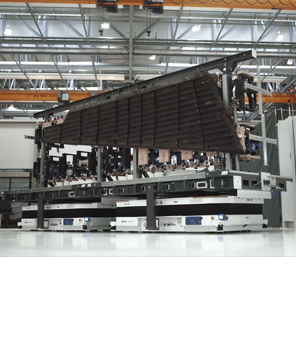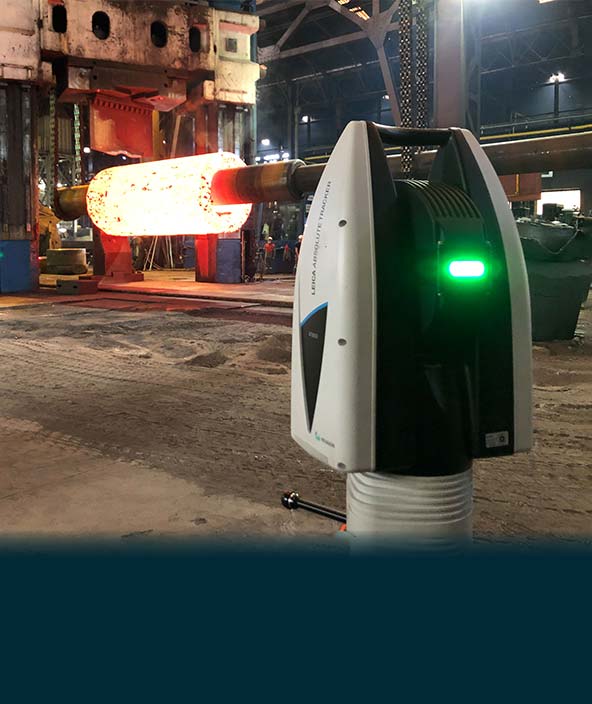Reflector network test: Trusting the ATS600 as a laser tracker for reflector measurement
The ATS600 is noted for its unique direct scanning functionality, but how does it stack up as a traditional laser tracker?
The Leica Absolute Tracker ATS600 launched in 2019 with a focus on its ground-breaking direct scanning functionality – it can measure points with metrologygrade accuracy at a distance of up to 60 metres without the need for a mediating handheld device such as a reflector, probe or scanner at the point of measurement.
Despite this ground-breaking functionality, based on Wave Form Digitiser technology, the ATS600 remains a fully functional 3D laser tracker, and is capable of reflector measurement at distances of up to 80 metres thanks to its integrated Absolute Distance Meter technology.
But how does this performance compare to Hexagon’s other 3D laser tracker options? This is a question that customers often have – can the ATS600 really serve as a reflector-measurement device in the same way as our dedicated 3D laser tracker systems, the Leica Absolute Tracker AT930 and Leica Absolute Tracker AT500? Let’s take a look how these systems perform and the published specifications of our laser tracker range to see how the ATS600 stacks up.
A look at the specifications
Full accuracy specifications for our laser trackers are published in our complete laser tracker brochure. As you can see from the tables below, angular accuracy and length measurement accuracy are very comparable between the ATS600 and reflector measurement with our other laser trackers, including our flagship laser tracker, the Leica Absolute Tracker AT960.
![]()
Figure 1.
Angular performance (location test)
Angular performance, evaluated through a location test, is exactly the same for all of our trackers models. Length measurement accuracy tolerance, established through a length test, is 25 percent higher over short distances with the ATS600, but equivalent at distances of 10 metres or more from the tracker.
![]()
Figure 2.
Lenght measurement (length test)
There is however a clear difference in accuracies when it comes to distance measurement, established by a ranging test.
So the big question is how much does this difference affect real laser tracker reflector measurement use cases?
Performing a network test
In 2011, the National Physical Laboratory (NPL) in the UK published a paper titled Laser tracker error determination using a network measurement. The paper describes a ‘network test’ that involves setting up a laser tracker within a defined measurement volume of approximately 8 by 8 metres. The volume should have 5 tracker stations, and 15 different reflector positions, all spread across three different heights (one on the floor, two at normal tracker height and one set at two metres high).
The specifics of this setup allow it to be used to explore the following aspects of tracker performance:
- Vertical encoders – by measuring points at different heights.
- Horizontal encoders – by measuring points spread around the volume and by rotating the instrument on its axis.
- Distance – by measuring from near-to-far away from the tracker.
The NPL describes this in their paper as “a fast, easily implemented method to determine all the geometrical alignment errors of a laser tracker, to high precision”.
A volume as specified by the NPL was set up in the testing area of the Absolute Tracker R&D headquarters in Switzerland, measuring 10 by 8 by 3 metres and using 5 tracker stations and 17 target locations. The network was then used to assess the relative performance of an ATS600 versus an AT960 laser tracker for reflector measurements.
![]()
Figure 3.
Distance measurement (ranging test)
![]()
Figure 4.
Testing area to assess the relative performance of an ATS600 versus an AT960 laser tracker for reflector measurement
Network test results
Both the AT960 and the ATS600 were used to measure all 17 target points from each of the 5 tracker positions. A Unified Spatial Metrology Network was created for each in Hexagon’s SpatialAnalyzer metrology software to bundle the stations and calculate average results.
In this test report which was accomplished with one unit of each model, the difference of only 2 microns in average point deviation can be considered negligible.
![]()
Figure 5.
Test report with one unit of each model
Although the specification of distance accuracy for the AT960 and ATS600 are quite different, the angular performance was the dominant source of errors, and this is equivalent between the systems.
In conclusion, we have found that the ATS600 can be confidently used in typical AT960/AT930 reflector measurement applications with only a minor loss in accuracy.
![]()
Figure 6.
Unified Spatial Metrology Network in Hexagon’s SpatialAnalyzer

